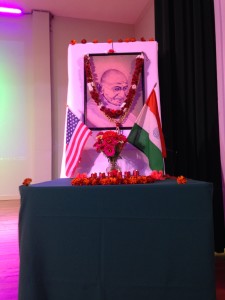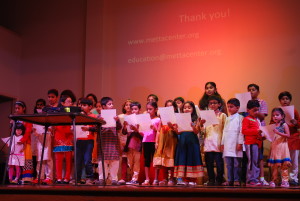 The India Center in Charleston, West Virginia celebrates Gandhi Jayanti, (Spinning Wheel Day, in honor of Gandhi’s birthday, October 2) each year by inviting a guest speaker to talk about a different theme relating to Gandhi and nonviolence. The celebration also includes dinner, interfaith prayers, songs by the children’s choir, and a poster and essay contest for school-aged youth.
The India Center in Charleston, West Virginia celebrates Gandhi Jayanti, (Spinning Wheel Day, in honor of Gandhi’s birthday, October 2) each year by inviting a guest speaker to talk about a different theme relating to Gandhi and nonviolence. The celebration also includes dinner, interfaith prayers, songs by the children’s choir, and a poster and essay contest for school-aged youth.
I was really impressed with the entries and how much the children were taking Gandhi’s message to heart. To paraphrase Gandhi paraphrasing Maria Montessori, if we are to have peace, we must begin with the children, and these children give much hope in their early studies and appreciation of Gandhi’s life and legacy of nonviolence.
As this year’s guest speaker, I was invited to give a talk on behalf of the Metta Center. I chose to focus my talk on Gandhi’s nai talim or “new education”, looking at where education sits within his conception of nonviolence, and exploring what lessons we can learn from Gandhi’s view of education and how we can apply them in today’s world. You can view the slides from the presentation here.
Gandhi’s new education was a response to the British colonial system of education, which he saw as facilitating and perpetuating the British rule over the Indian people. In order to gain freedom, they had to reclaim the way they were educating their citizenry, and Gandhi’s nai talim was his vision of how education could be a source of liberation rather than oppression.
One of the most important aspects of nai talim is that education should reflect and be grounded in the local context, roote d in reality. The British colonial education system was rooted in British reality, and had little relevance to the daily lives of the average Indian student. This is still a problem for many students today, who are often left wondering how what they are learning in school is connected to their own lives outside the classroom.
d in reality. The British colonial education system was rooted in British reality, and had little relevance to the daily lives of the average Indian student. This is still a problem for many students today, who are often left wondering how what they are learning in school is connected to their own lives outside the classroom.
As I prepared for the talk, reflecting on our reality today, we collectively felt the shock of another school shooting, this time at Umpqua Community College in Oregon. As a community college professor myself, this felt particularly close to home. En route to the talk as I flew across the country, two more campus shootings occurred in Texas and Arizona. I couldn’t very well talk about nonviolence in education without acknowledging the violence that is taking place within our educational institutions – which takes the form not only of mass shootings, but also at other levels from bullying to the school-to-prison pipeline. This is the reality of the situation in which our education is taking place, and the reality that our students and teachers are facing in schools. We must acknowledge this reality – and education must seek to address it.
How can education be a part of the solution to this epidemic of violence in the US? In the public discourse around school shootings, we talk about gun control and mental health services, both of which are clearly important, but rarely, if ever, is education offered as part of the solution. Exploring nai talim can give us some ideas of how education can address our culture of violence.
Stay tuned for Part 2 of this post, in which we will explore nai talim further!








